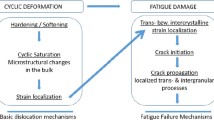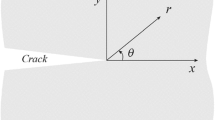Abstract
Microcrack initiation and propagation in mechanical fatigued polycrystals are sensitive to crystallographic misorientation between grains. The analysis of factors affecting the propagation of microcracks requires quantitative knowledge about the crystallographic misorientations of the grain boundary segments in which microcracks have been observed. Such observations are possible using the electron back-scattering pattern technique in the scanning electron microscope. The principle of this method is explained and some examples of such investigations on nickel polycrystals in push-pull tests are presented.
Similar content being viewed by others

References
G. Dörr and C. Blochwitz, “Microcracks in fatigued fcc polycrystals by interaction between persistent slip bands and grain boundaries,”Cryst. Res. Technol,22, 113–121 (1987).
C. Blochwitz, G. Dörr, I. W. Kramarenko, and A. J. Krasowski, “Nucleation and propagation of fatigue cracks in coarse-grained nickel,”Z. Metallkunde,82, 354–360 (1991).
D. J. Dingley and V. Randle, “Microtexture determination by electron back-scatter diffraction,”J. Mater. Sci.,27, 4545–4566 (1992).
K. Z. Troost, “Thin-film crystallography by electron back-scattering patterns in the scanning electron microscope,”BEDO, Philips Research Lab., Eindhoven, Dec. 1992.
N. H. Schmidt, J. B. Bilde-Sorensen, and D. Juul-Jensen, “Band positions used for on-line crystallographic orientation determination from electron back scattering patterns,”Scanning Microscopy,5, 637–643 (1991).
P. J. Henderson and P. N. Quested, “Some preliminary experiments using electron back-scattering patterns,”National Physical Lab., Teddington, Middlesex, UK, Crown Copyright (1986).
J. Polak and P. Liskutin, “Nucleation and short crack growth in fatigued polycrystalline copper,”Fatigue Fract. Eng. Mater. Struct.,13, 119–133 (1990).
L. C. Lim and R. Raj, “The role of residual dislocation arrays in slip induced cavitation, migration and dynamic recrystallization at grain boundaries,”Acta Metall,33, 2205–2214 (1985).
L. C. Lim, “Surface intergranular cracking in large strain fatigue,”Acta Metall.,35, 1653–1662 (1987).
Z. Wang, T. Hu, Y. Xia, and Q. Yang, “Intergranular fatigue cracking and the role of grain boundary structure in high purity aluminium,”Chin. J. Met. Sci. Technol,2, 367–371 (1986).
H. Heinz and P. Neumann, “Crack initiation during high-cycle fatigue of an austenitic steel,”Acta Metall. Mater.,38, 1933–1940 (1990).
J. Gemplerova, V. Pejdar, and F. Kroupa, “Compatibility stresses in deformed bicrystals,”Czech. J. Phys., B39, 427–446 (1989).
P. Peralda, A. Schober, and C. Laird, “Elastic stresses in anisotropic bicrystals,”Mater. Sci. Eng., A169, 43–51 (1993).
W. H. Kim and C. Laird, “Crack nucleation and stage I propagation in high strain fatigue,”Acta Metall.,26, 777–799 (1978).
T. Inoque, T. Hoshide, T. Yoshikawa, and Y. Kimura, “Slip-band behaviour and crack initiation in polycrystalline copper under multiaxial low-cycle fatigue — a damage mechanics approach,”Eng. Fract. Mech.,25, 665–675 (1986).
C. Li and T. Bretheau, “The role of grain boundary compatibility in fatigue cracking of aluminium bicrystals,”Acta Metall.,37, 2645–2650 (1989).
H.-J. Christ, “On the orientation of cyclic-slip-induced intergranular fatigue cracks in face-centred cubic metals,”Mater. Sci. Eng., A117, L25-L29 (1989).
U. Essmann, U. Gösele, and H. Mughrabi, “A model of extrusions and intrusions in fatigued metals, I. Point-defect production and the growth of extrusions,”Phil Mag., A44, 405–426 (1981).
F.-U. Herbig and D. Heinrich, “Untersuchungen zu Rissen, die durch persistente Gleitbönder an Korngrenzen erzeugt werden,”Diplomarbeit, Padagog. Hochschule Dresden (1986).
M. Hecker, “Theoretische Untersuchungen zu Eigenspannungsfeldern von Defekten in Körpern mit inneren und äußeren Grenzflächen. Thesis, Techn. Universität Dresden (1993).
Author information
Authors and Affiliations
Additional information
Published inProblemy Prochnosti, Nos. 1–2, pp. 11–25, January–February, 1995.
Rights and permissions
About this article
Cite this article
Blochwitz, C., Brechbühl, J. & Tirschler, W. Misorientation measurements near grain boundary cracks after fatigue tests. Strength Mater 27, 3–13 (1995). https://doi.org/10.1007/BF02206406
Issue Date:
DOI: https://doi.org/10.1007/BF02206406



